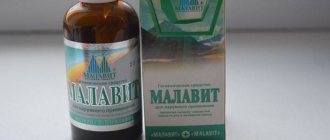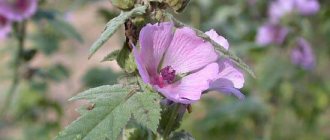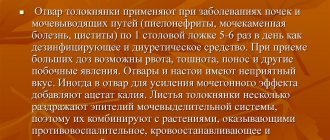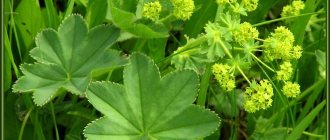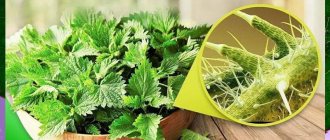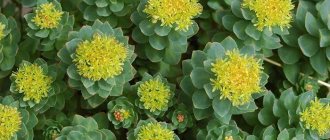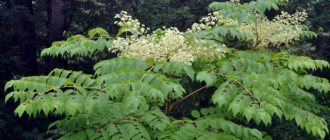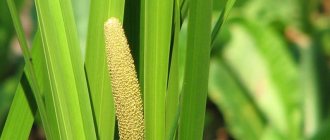Echinacea is a low perennial plant with a short rhizome with many thin roots. The stems of the plant are leafy, simple, but highly branched. The stems contain rough, alternately arranged leaves that become smaller towards the top of the stem. At the top of the Echinacea stem there is a flower basket with a ball-shaped receptacle. The flower basket consists of reed flowers, ranging in color from pink to purple. Summer is the period when Echinacea blooms and beautiful bright flowers appear on the stems. In the center of the basket there are tubular flowers - they are the ones that bear fruit.
Echinacea is distributed throughout Russia, the North Caucasus and Ukraine. It prefers to grow in full sun, fertile and at least slightly drained soil.
Morphological description
The height of the plant reaches 80–120 cm. The stems are straight or slightly branched, covered with bristly hairs. The multi-headed rhizome is highly branched, numerous roots penetrate deeply into the soil; when cut they have a very pungent taste.
Leaves are divided into two types: stem and basal:
- The stem leaves are lanceolate in shape, narrowed towards the petiole, have a lush green color, and are rough to the touch. They are arranged alternately on the stem.
- The basal leaves are slightly serrated, located on long petioles collected in rosettes. The shape resembles a wide oval, sharply narrowed towards the petiole.
Blooms in the 2nd year of life. Flowering begins at the end of May - beginning of July, the duration of this period is up to 75 days. The inflorescences are purple-violet, rather large baskets and shaped like a chamomile. The size of the baskets is 10-12 cm. The core consists of tubular-shaped flowers of reddish or brown color and protrudes dome-shaped above the inflorescence. Reed flowers are pointed at the ends and have an underdeveloped pistil; and bisexual tubular ones are distinguished by a reddish-brown color.
Propagates well by seeds and grown through seedlings. Can reproduce by dividing the rhizome. Only tubular flowers bear fruit. The fruit is a tetrahedral, oblong brown achene, 5–6 mm long, with a small tuft.
Biological characteristics
Echinacea purpurea is a perennial plant native to the eastern part of the North American continent. It belongs to the Asteraceae (Asteraceae) family.
The height of the straight leafy and highly branched rough stems reaches 1 m. The bright pink or purple reed and tubular flowers of Echinacea are collected in large (up to 15 cm) inflorescence-baskets.
Flowering time in our country is from mid-summer to early autumn. Echinacea blooms for the first time in its second year.
This plant is cultivated as an ornamental and medicinal plant; it does not grow well in shaded areas and prefers well-drained, fertile soils, although it is quite drought tolerant. Echinacea tolerates low temperatures well, which determines its wide distribution area.
Rhizomes, as well as aerial parts - stems, leaves and flowers - are harvested as medicinal raw materials. It is recommended to dry in attics with good air circulation.
Stories and applications
Echinacea was first described by Carl Linnaeus in his works on botany. Since the 70s of the 20th century, it began to be grown as a garden crop, and several varieties were bred.
The Soviet scientist S.A. Tomilin studied this plant in great detail and recommended echinacea preparations for tonsillitis, sore throat, depression, fatigue (mental and physical), parametritis, inflammatory processes in internal organs, acute and chronic infectious diseases (typhoid fever, erysipelas, diphtheria, osteomyelitis, cerebral meningitis), as well as for the treatment of wounds, burns, ulcers. His work greatly contributed to the introduction of the plant into traditional medicine and homeopathy.
In folk medicine, the plant was used to a greater extent to treat various infections and wounds.
Some plant varieties, including purple, are grown by gardeners for decorative purposes, decorating flower beds and front gardens. It blooms beautifully and for a long time, and looks very aesthetically pleasing, and lasts a long time in a vase after cutting.
Collection and preparation, cultivation
In folk medicine, it is recommended to harvest all parts of the plant:
- flower baskets are cut from the stems in July-August;
- grass - at the very beginning of flowering;
- roots with rhizomes, which are at least 4 years old - in late autumn.
The roots are washed and dried in the shade. The grass and inflorescences are also dried in the air, in a well-ventilated place, in the shade.
The shelf life of the grass is 6 months, inflorescences – 1 year, roots – 2 years.
The seeds of this useful plant can be purchased in the gardening department of the store. It will take a long time to germinate them, more than a month, so they should be planted in February (they love warmth and moisture). Seedlings are planted in the ground at the end of May, in light, fertilized soil, choosing a well-lit place. Flowering of the bushes begins in the 2nd year.
A simpler way is to divide the root. This can be done in spring or autumn by planting part of the root shoots deep into the hole.
Chemical composition and medicinal properties
The plant contains a whole storehouse of useful substances that have a complex healing effect:
- potassium is involved in maintaining water-salt balance, important for normal heart function;
- calcium prevents the accumulation of harmful cholesterol and strengthens bone tissue;
- iron is part of hemoglobin and is involved in the transfer of oxygen in the blood;
- Selenium, being a powerful antioxidant, protects organs and systems from the action of free radicals and prevents the development of cancer;
- silicon strengthens blood vessels, participates in the formation of cartilage and connective tissue;
- cobalt is involved in metabolism and hematopoiesis;
- zinc has a positive effect on the condition of hair, skin and nails;
- manganese helps the central nervous system and thyroid gland;
- vitamin A and carotene are involved in vision function; vit. A is a powerful antioxidant;
- Vitamin C strengthens the walls of blood vessels, improves immunity and has an anti-inflammatory effect;
- Vitamin E is another antioxidant that strengthens the immune system;
- phenolcarboxylic acids have pronounced immunostimulating, antiseptic and diuretic properties;
- polysaccharides are involved in the production of interferons, which are directly involved in the implementation of antiviral immunity. Accelerate the restoration of damaged tissues;
- flavonoids improve antiviral protection, help fight carcinogens, allergens, increase vascular permeability and have an antispasmodic effect;
- polyenes have an antifungal effect;
- tannins have anti-carcinogenic and anti-inflammatory effects;
- inulin has a beneficial effect on intestinal function and helps in the fight against diabetes;
- betaine is a substance that is one of the factors in the prevention of stroke and heart attack;
- synarin increases resistance to infectious and viral diseases, speeds up the recovery of patients suffering from acute respiratory viral infections.
The essential oil, which is contained in all parts of the plant (in flowers - up to 0.5%, in grass - up to 0.35%, in roots 0.05-0.25%) is rich in non-cyclic sesquiterpenes, which have fungicidal and bactericidal activity. The plant also contains resins (about 2%), organic acids (linoleic, palmitic, cerotinic), fats, silicates, phosphates, chlorides, fiber, which play a certain role in the positive complex effect.
According to research, taking preparations based on Echinacea purpurea increases the number of leukocytes in the blood by an average of 50% and enhances the activity of the protective properties of the liver.
Thus, the echinacea herb has the following medicinal properties: immunomodulatory, anti-inflammatory, antimicrobial, antiviral, anticarcinogenic, antiallergic, antispasmodic, anti-aging, hepatoprotective. Plant preparations are highly active against staphylococcus, streptococcus, E. coli, influenza viruses, and herpes.
Uses of Echinacea
In terms of its usefulness, Echinacea purpurea is often compared to ginseng - the famous “root of life” and is called no less majestic - a plant for a thousand diseases. The beautiful plant is also called the “blood purifier.”
The plant is included in more than 240 drugs, including patented drugs for the treatment of AIDS.
Monopreparations of the plant are used for a variety of conditions:
- mental and physical fatigue;
- mental depression;
- infectious diseases: scarlet fever, erysipelas, gonorrhea, osteomyelitis, tonsillitis, tonsillitis, cerebrospinal meningitis, septic conditions;
- respiratory and viral diseases: ARVI, herpes, influenza, viral rhinitis (treatment and prevention);
- inflammatory diseases: rheumatoid arthritis, polyarthritis, hepatitis, nephritis, cystitis, adnexitis, prostatitis, gastritis, pancreatitis, cervical erosion;
- diseases associated with metabolic disorders: diabetes mellitus, obesity, liver disease (as a drug to improve immunity);
- leukopenia caused by irradiation or treatment with cystostatics;
- potency disorders;
- male and female infertility (in complex treatment);
- in complex treatment for alcoholism and smoking;
- condition after operations, long-term treatment with antibiotics, chemotherapy;
- pain syndrome: headache and joint pain;
- skin lesions: eczema, psoriasis, burns, frostbite, trophic ulcers, purulent deep wounds, carbuncles, abscesses, insect bites.
It is used for prophylactic purposes in case of early signs of colds, during long-term antibacterial therapy, for the recovery of people who have suffered from radiation or who live in areas unfavorable in terms of radiation levels.
There are documented cases of echinacea curing patients suffering from cutaneous lupus erythematosus, although autoimmune diseases are a contraindication to treatment.
Doctors advise using plant preparations at the first signs of a cold or flu in parallel with the main treatment: the plant can increase the effectiveness of traditional methods of therapy by 20-40%.
Scientific Research on Echinacea
Since the beginning of its use by folk healers, the plant has been of interest to official medicine. Scientific research into the properties and capabilities of Echinacea has been and is still being carried out in many countries. Let's list some of them.
- In 2001, domestic scientists conducted a double-blind, placebo-controlled study of the effectiveness of plant preparations in the treatment of patients with ARVI. The study involved 80 people, each of whom had early symptoms of ARVI. The patients were divided into 2 groups: group 1 received Echinacea purpurea, group 2 received placebo. According to the observation results, the average duration of the disease in the 1st group was 6 days, in the second - This allowed us to conclude that plant preparations can reduce the duration of viral infections.
- A parallel double-blind study was aimed at studying the effect of plant preparations on the severity and frequency of colds and flu in people with increased susceptibility. The trial involved 108 patients: half of them received 2-4 ml of echinacea juice per day, and the second group received a placebo. Patients who received the plant juice got sick less often, the periods between illnesses became longer, and the symptoms became less severe. Thus, the feasibility of using echinacea in patients with a reduced immune response has been proven.
- Another study only confirmed the effectiveness of plant preparations in the treatment of viral infections of the upper respiratory tract. This scientific work involved 282 healthy people aged 18-65 years, who had previously suffered from colds 2 or more times a year. At the first signs of colds, half of the patients received echinacea extract: 10 doses for the earliest symptoms of the disease, and 4 doses over the next 7 days. Patients were examined on days 3 and 8 of illness.
During the observation period, 128 people fell ill: 59 of them received echinacea extract, and 69 received placebo. Patients who took the extract had 23.1% less symptoms of the disease.
- The results of a study by scientists from Canada's McGill University, conducted on mice, suggested that plant preparations can prolong the life of patients suffering from leukemia. The significant genetic similarity allows the study results to be extrapolated to humans, but more testing is needed.
The study was conducted on mice with leukemia. After 13 months of using echinacea preparations, 74% of mice from the experimental group remained alive, while the survival rate of animals that did not receive the drug was only 46%. There was also an increase in the number of natural killer cells in the spleen and bone tissue of mice treated with the plant preparation. Based on this, scientists concluded that the use of plant preparations is useful for preventive purposes - to increase the number of immune cells that play a key role in protection against cancer, the risk of which increases with age.
- Echinacea can be used as an auxiliary drug in the treatment of cancer. The study involved 55 patients after a course of radiotherapy: 85% had a stable white blood cell count. In patients who did not take the plant preparation, a steady decrease in the number of leukocytes was noted.
- The anti-inflammatory properties of the plant allow it to be used as an adjuvant in the treatment of rheumatoid arthritis. One recent study showed that using 15 drops of the plant extract three times a day can reduce the severity of the inflammatory response by 20-25%.
Plant preparations increase the body's natural defenses and have a stimulating effect on the immune system. Moreover, the positive effects “work” not only in adults, but also in children with an unformed immune system, and in elderly people whose protective functions of the body are reduced due to the general aging of the body.
Traditional medicine recipes
It should be understood that Echinacea and its products cannot be considered as monopreparations, but only as an addition to the main treatment.
Universal alcohol tincture of Echinacea
Can be used for all of the pathologies listed above, with the exception of alcoholism, since it contains alcohol.
Pour raw crushed root or fresh flowers with 70% alcohol 1:4 and leave in a dark place for 1 month or more. Take half or a whole teaspoon 3 times a day for 10 days in a row.
The same tincture can be used externally (diluted halfway with chilled boiled water) to treat wounds, carbuncles, abscesses and healing burns (treatment, wet compresses). It also helps against herpes (cauterizing herpetic eruptions 3-5 times a day).
The second recipe for vodka tincture
Helps with the onset of acute respiratory viral infections, and is used to prevent viral infections.
Take echinacea flowers, place them in a half-liter jar so that the volume is filled to the top, fill with high-quality vodka and close the lid tightly. Leave in a dark place for 40 days. Next, drain and strain the preparation. Take 15 drops half an hour before meals, diluted in a small amount of water or adding the tincture to tea, 3 times a day.
Tincture made from the raw root of the plant
Recommended for the treatment of chronic gastritis, pancreatitis, psoriasis and allergic rashes on the skin and mucous membranes.
Take 1 part of raw roots and pour 5 parts of vodka over them, leave in a dark place for 30 days. Take 15-20 drops, diluted in water, 3 times a day.
Tea
Helps with flu, colds, inflammatory processes, after serious illnesses, surgeries, after treatment with antibiotics, and with alcoholism. It can also be used for eczema, ulcers and boils.
Take 3 pcs. fresh echinacea flowers or dry raw materials from crushed roots and leaves (2 tsp), pour half a liter of boiling water and leave for 40 minutes. To prevent diseases, it is enough to take 1 glass per day, and for treatment – 3 glasses per day. This tea rejuvenates the body and slows down the aging process.
Echinacea decoction
Recommended for flu and colds, coughs, swelling, stomach ulcers, headaches, joint pain. It also improves vision, stimulates appetite, normalizes blood pressure, and is characterized by a tonic and restorative effect. For streptococcal skin infections, psoriasis and snake bites, local lotions are made from the decoction on damaged areas of the skin.
Take 1 tsp. fresh or dry echinacea leaves, pour 200 ml of water, heat in a water bath for half an hour, then leave and strain. Take a third of a glass 3 times a day, before meals.
Infusion
Recommended for preventive use in winter, during the cold season. Strengthens the immune system, stimulates physical activity, relieves fatigue.
Take 30 gr. fresh or dried flowers, place in an enamel saucepan, pour 500 ml of boiling water, cover with a lid and boil for 10 minutes. Leave in a warm place for 4-5 hours, strain and add syrup, sugar, honey or juice to taste. Drink half a glass 3 times a day.
Juice of fresh inflorescences
Helps speed up the healing process of wounds, treats acne, ulcers, warts, and with long-term use eliminates age spots and freckles. Effective in the treatment of ARVI.
To obtain it, the inflorescences are crushed and the juice is squeezed out of the pulp. Use undiluted, 3-5 ml per day. before meals. Externally - treat the affected skin 3-4 times a day.
Oil extract from the roots of the plant
Helps in the treatment of peptic ulcers and gastritis. Lotions with the drug are used in the treatment of burns and bedsores. Tampons moistened with beneficial oil help in the treatment of cervical erosion (administered at night).
Take 1 glass of unrefined olive oil and 50 g. chopped roots, leave for 1 month. Take 1 tsp orally. 60 minutes before meals, twice a day.
Remedy for headaches, high blood pressure and nervous tension
Take the dry parts of the plant and grind them to a powder. Mix 100 g of powder with 300 g. honey and mix thoroughly. Take 3 times a day, with tea, 1 tbsp.
Pharmacy Medication Options
Pharmacies sell many dosage forms with Echinacea. For folk recipes, dried and crushed plant materials – leaves or flowers – are produced. They are usually used for external use in cosmetology or dermatology. Decoctions, healthy vitamin teas, and alcohol infusions are prepared from dried leaves or inflorescences.
There are also a number of standardized, ready-to-use dosage forms. These include:
- Tablets/capsules. These supplements containing the echinacea plant are intended for use in adults and children over 12 years of age. There are also lozenges that help with sore throat and severe cough.
- Tinctures. They are intended for oral administration and for adults only. The medicine is dosed drop by drop and dissolved in half a glass of water.
- Syrups. These forms of Echinacea are used in children after 3-4 years of age to stimulate the immune system. Syrups usually have a pleasant taste. But these supplements are not suitable for diabetics as they contain sugar.
- Sprays. In addition to echinacea, propolis and other herbal ingredients are often added to these preparations. Sprays relieve sore throats and are prescribed mainly for tonsillitis and pharyngitis.
- Oils. These solutions are used externally for papillomas, to heal the skin, get rid of acne and wrinkles. They can also be taken orally for inflammatory diseases.
- Ampoules. Used for intramuscular or subcutaneous injections in the treatment of intoxication syndrome and inflammatory processes.
Echinacea for children
Herbalists and traditional healers recommend using plant preparations in pediatrics, starting from 1 year. Representatives of official medicine are somewhat more restrained about such conclusions and advise not to use echinacea preparations before 3 years. Preferred dosage forms are syrup, tea, decoction. Alcohol tincture can be used for children under 12 years of age only externally, to treat acne and skin lesions.
Echinacea preparations are recommended for children primarily to strengthen immune defense and increase resistance to infectious agents that children constantly encounter in kindergarten and school. Also used in complex therapy of viral and bacterial infections of the respiratory system, ENT organs, oral cavity, skin and genitourinary tract.
Drug interactions
Taking Echinacea should not be combined with immunosuppressive drugs. It is not advisable to combine the plant with drugs that have an immunostimulating effect. Their combined use will lead to a deterioration in health.
With the simultaneous use of echinacea and antiviral drugs, the effect of the latter is enhanced. And if you combine an alcohol tincture with cephalosporins, the following side effects occur:
- profuse sweating;
- tachycardia;
- nausea;
- redness of the skin.
Nature's Bounty, Echinacea, 400 mg, 100 Capsules
★★★★★
481 ₽
Buy at a discount
Pharmaceutical preparations with Echinacea
The plant is included in many drugs and dietary supplements. Let's take a closer look at the most popular ones.
Lozenges with EchinaceaImmunostimulating agent for the prevention of acute respiratory infections and acute respiratory viral infections. It is used in the complex therapy of influenza and colds, especially in the initial stages, and also as an auxiliary drug for recurrent urinary and respiratory tract infections. |
Echinacea Forte, oral solutionIndicated for activation of nonspecific protective factors in acute infectious diseases that occur without complications, with a predisposition to frequent and long-term colds, for the prevention of acute respiratory viral infections and influenza. Recommended as an adjuvant drug for long-term antibiotic therapy of chronic infections. |
Echinacea purpurea tinctureOne of the most popular dosage forms, which is indicated in the complex treatment of acute respiratory viral infections, influenza, colds, infections of the ENT organs, and herpetic infections. Recommended for strengthening the immune system in severe chronic diseases, after antibiotic therapy. It is also used externally for burns, trophic ulcers, and long-term non-healing wounds. |
Dry raw materials that are used to prepare infusions, decoctions, and teas. Indications are similar to tincture. |
conclusions
After reading the article, you learned how to use echinacea to boost immunity in children and adults. This herbal medicine is sold in tablets and as an alcohol tincture. Many people believe that it helps against colds. But in reality this has not been proven. It is probably not worth overpaying for the expensive drug Immunal. Instead, you can ask the pharmacy for domestic echinacea tincture or tablets. The article details not only the medicinal properties, but also contraindications and possible side effects. Research them before taking Echinacea purpurea or giving it to a young child.
If there are no contraindications, then you can try echinacea for the prevention and treatment of colds in children and adults. But don't expect miracles from this remedy. It will not make anyone completely immune to infections. Consult your doctor if you are taking any other immune stimulating medications to avoid overload. Compare the duration and severity of colds with and without taking echinacea. This way you can conclude whether this remedy helps you or not.
Contraindications for use and restrictions
- Individual intolerance;
- Allergic reactions to any member of the family (especially for children);
- HIV and AIDS;
- Leukemia;
- Tuberculosis;
- Atherosclerosis;
- Autoimmune diseases;
- Children up to 2 years of age (for drugs containing alcohol – up to 12 years).
It is not recommended to be treated with Echinacea for more than 10 days in a row. After a break of 3-5 days, the course of treatment can be repeated. During pregnancy and breastfeeding, plant preparations are prohibited for use.
This treatment should be used with caution by persons prone to allergies, patients with allergic rhinitis and bronchial asthma.
Young men are not recommended to take plant preparations, since during treatment there is a decrease in sperm motility, and this leads to difficulty in fertilization.
Echinacea should not be used in combination with immunosuppressants, glucocorticosteroids and cytokines.
Side effects
Pills
Allergic reactions are possible (in the form of skin hyperemia, skin rash, facial swelling), decreased blood pressure, sweating, shortness of breath.
Lozenges, lozenges
Allergic reactions are possible (in the form of itching, swelling of the face, skin rashes, low blood pressure, dizziness, difficulty breathing).
In cases of hypersensitivity reactions, Echinacea is discontinued.
Homeopathic granules
Allergic reactions are possible.
